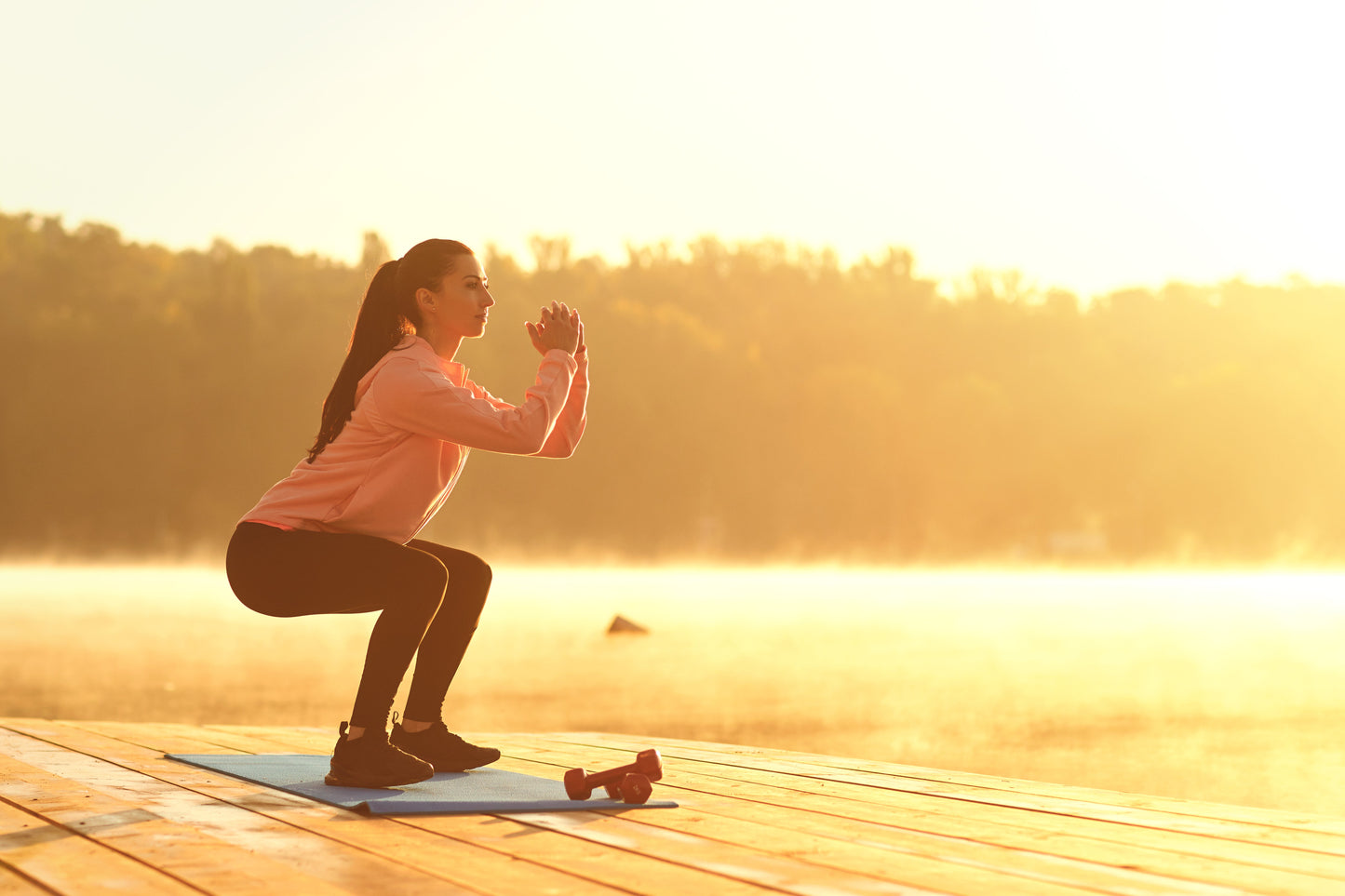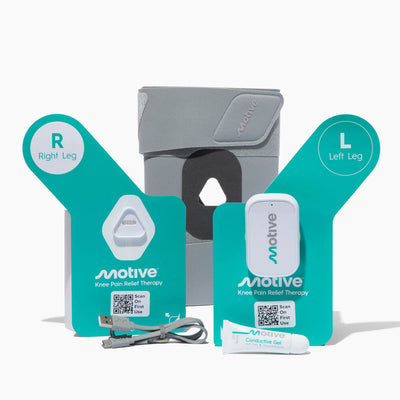
Key Takeaways
-
Strong quads are essential for knee stability and reducing pain during daily activities.
-
Proper form and progression are crucial for safe, practical training of quads.
-
Combining traditional exercises with innovative solutions, such as Motive, can accelerate results.
-
Consistency beats intensity when building muscular quads and supporting knee joint health.
Studies confirm that weak quad muscles are one of the leading causes of knee instability and pain. If you experience knee pain when climbing stairs, feel unsteady when walking, or struggle with daily activities, your quadricep muscles might need attention.
The good news is that targeted quadriceps exercises can transform your knee health and restore your confidence in movement.
Your quadriceps—the powerful muscle group at the front of your thigh—play a crucial role in supporting your knee joint and maintaining proper alignment during every step.
Are you an active individual looking to prevent injury or seeking relief from knee pain? Strengthening these key muscles is one of the most effective strategies you can implement.
This guide will walk you through the best quad exercises, ranging from gentle movements suitable for beginners to more challenging variations for advanced fitness enthusiasts.
We’ll also explore how innovative solutions like Motive’s FDA-cleared therapy can complement your exercise routine for enhanced results.
The Role of the Quadriceps
The quadriceps consist of four distinct muscles that work together as one powerful unit.
Source: Cleveland Clinic
The rectus femoris runs down the center of your thigh, while the vastus lateralis, vastus medialis, and vastus intermedius surround it. Together, these leg muscles control knee extension and provide stability during hip flexion movements.
Several factors can weaken your quad muscles over time. Prolonged sitting, previous injuries, aging, and conditions like osteoarthritis can all contribute to quadricep muscle deterioration. Additionally, compensatory movement patterns often develop when people avoid using joints that hurt, which can lead to further weakness.
Signs that your quads need strengthening:
-
Difficulty rising from chairs
-
Knee instability when walking on uneven surfaces
-
Pain or fatigue when climbing stairs
-
Bending your knee feels uncomfortable
-
Sitting upright becomes challenging during certain activities
Benefits of Strengthening Your Quadriceps
Developing strong quads offers numerous advantages that extend beyond building impressive leg muscles. These include improved knee joint alignment and reduced stress on cartilage and surrounding structures. This improved alignment can significantly decrease knee pain and slow the progression of degenerative conditions.
Stronger quad muscles also boost balance and coordination, making daily activities easier and safer—be it navigating stairs, getting up from a squat position, or participating in sports.
For active individuals, quad strength directly translates to improved performance and reduced risk of injury. Strong quadriceps support proper landing mechanics during jumping activities and provide the power needed for explosive movements. Even for those recovering from knee surgery, targeted quad exercises form a cornerstone of rehabilitation programs.
Best Quadricep Exercises to Strengthen Your Knees
The following quad exercises are the most effective for building strength, improving function, and supporting knee health. You can modify each movement to match your current fitness level and gradually progress as you grow stronger.
1. Seated Leg Extension (Beginner)
The seated leg extension is an excellent starting point for those new to training quads or recovering from injury. This exercise isolates the quadricep muscles while providing excellent control over resistance and range of motion.
-
Sit on a sturdy chair with your back supported and feet flat on the floor.
-
Slowly lift your right leg until it's straight.
-
Hold for 2-3 seconds, then slowly lower back to the starting position.
-
Complete 10-15 repetitions before switching to your left leg.
If you have access to a leg extension machine, you can perform this movement with added resistance for increased muscle growth.
For home workouts, try kneeling leg extensions as a variation. Start kneeling and slowly lift one leg behind you, focusing on contracting your quad muscles throughout the movement.
2. Wall Sits (Beginner to Intermediate)
Wall sits build endurance in your quadriceps while requiring just your body weight and a wall. This isometric exercise teaches proper squat position alignment while strengthening the entire muscle group.
-
Stand with your back against a wall and your feet hip-width apart, about two feet from the wall.
-
Slowly lower into a squat position until your thighs are parallel to the floor, keeping your torso upright and upper chest proud.
-
Hold this position for 20-60 seconds, maintaining proper form throughout.
As you progress, try holding the position longer or adding a narrow stance variation to challenge different aspects of your quad strength.
3. Straight Leg Raises
This low-impact exercise is ideal for individuals experiencing knee pain or mobility limitations. Straight leg raises target the rectus femoris and vastus medialis while being gentle on the knee joint.
-
Lie on your back with your right leg bent and right foot flat on the floor.
-
Keep your left leg straight and slowly lift it to match the height of your right knee.
-
Hold for 2 seconds, then slowly lower to the starting position.
-
Perform 10-15 repetitions on each side.
This exercise can be performed anywhere without equipment, making it an excellent choice for consistent daily practice.
4. Step-Ups
Step-ups translate directly to functional activities like climbing stairs and getting into vehicles. This unilateral exercise challenges one leg at a time while improving balance and coordination.
-
Stand facing a sturdy step or platform with your feet shoulder-width apart.
-
Step up with your left foot, pressing through your heel to lift your body weight onto the platform.
-
Step down with control, leading with the same foot.
-
Complete 10-12 repetitions before switching to your right foot.
Focus on maintaining an upright torso throughout the movement and avoid pushing off with your back leg. The key is making your front leg do all the work.
5. Squats
Squats are among the most effective leg exercises because they engage multiple muscle groups simultaneously. They build functional strength while improving hip joint and ankle mobility.
-
Begin in a standing position with your feet shoulder-width apart.
-
Lower into a squat position by pushing your hips back and bending your knees, keeping your torso upright and your chest lifted.
-
Descend until your thighs are parallel to the floor or as low as comfortable. Keep your knees aligned over your ankles, avoiding any forward movement past your toes.
-
Return to the starting position by driving up through your heels.
-
Start with 2-3 sets of 10-15 repetitions.
You can also advance to a barbell squat using a squat rack, or try variations like the front squat or sissy squats for additional challenge.
6. Bulgarian Split Squats (Advanced)
The Bulgarian split squat is an excellent single-leg exercise that builds significant quad strength while challenging balance and stability. This advanced movement specifically targets the vastus medialis and improves unilateral function.
-
Stand 2-3 feet in front of a bench or elevated surface.
-
Place the top of your left foot on the bench behind you, keeping most of your weight on your front leg.
-
Lower into a lunge position until your front knee reaches about 90 degrees, then return to the starting position.
-
Focus on keeping your torso upright and front knee tracking over your toes.
-
Perform 8-12 repetitions on each side.
This exercise can also be performed as split squats without elevation for a less challenging variation.
7. Resistance Band Leg Press (At-Home Friendly)
The leg press using a resistance band provides variable resistance that accommodates your strength curve while being joint-friendly. This exercise mimics the traditional leg press machine but can be performed anywhere, making it a versatile option for use at home or in the gym.
-
Sit on the floor with legs extended and loop a resistance band around the balls of your feet.
-
Hold the handles at chest level with arms straight.
-
Push through your feet to extend your legs while controlling the band's resistance.
-
Return to the starting position with control.
This exercise allows for easy progression by using stronger bands or adjusting your foot position. It’s particularly beneficial for those who want the benefits of a leg press without gym equipment.
Tips for Getting the Most from Your Quad Workouts
These tips can make or break your workout success:
-
Proper warm-up is essential before any leg day routine. Spend 5-10 minutes engaging in light movement, such as walking or gentle leg swings, to prepare your muscles and joints. Dynamic stretches targeting your hip flexors and quad muscles can also improve your exercise performance.
-
Focus on maintaining perfect form rather than lifting heavy weights or performing high repetitions. Keep your torso upright during standing exercises, ensure your feet are flat on the ground, and move with control rather than momentum. Quality repetitions build strength more effectively than sloppy high-repetition sets.
-
Progressive overload is key to continued muscle growth and strength development. Gradually increase resistance, repetitions, or exercise difficulty as your quad muscles adapt. Track your workouts to monitor improvement and maintain motivation.
-
Consistency trumps intensity when building strong quads. Aim for 2-3 quad-focused sessions per week, allowing adequate recovery time between workouts. Your muscles grow stronger during rest periods, not just during exercise.
How Motive Knee Strengthens the Quadriceps
While traditional quad exercises form the foundation of knee strengthening, innovative solutions like Motive’s muscle stimulation therapy can significantly fast-track your results.
The FDA-cleared device targets one of the primary root causes of knee pain—muscle weakness—by strengthening the muscles around the joint through precise neuromuscular electrical stimulation (NMES).
For individuals who struggle with traditional exercises due to pain or mobility limitations, Motive provides an accessible way to activate and strengthen the quadricep muscles. The therapy can be used independently or alongside your regular exercise routine to accelerate muscle development and alleviate pain.
The science behind Motive demonstrates how controlled muscle stimulation can improve strength, reduce pain, and enhance functional capacity. Over 25,000 people have experienced the benefits of this innovative approach to knee health, making it a valuable tool in comprehensive knee pain treatments.
What sets Motive apart is its ability to provide consistent muscle activation regardless of your current fitness level or pain status. Whether you’re supplementing walking lunges with additional stimulation or using them on days when traditional exercises aren’t possible, Motive ensures that your quadriceps muscles continue to strengthen.
Take Charge of Your Knee Health
These exercises offer a comprehensive approach to strengthening your quadriceps muscles and promoting proper knee joint function.
Start with exercises appropriate for your fitness level and progress gradually as your quad muscles adapt. If you have specific concerns or limitations, consult with a physical therapist to ensure safe, effective training.
Combining traditional quad exercises with innovative solutions like Motive can maximize your results. Combining muscle-strengthening exercises with Motive’s targeted muscle stimulation offers a powerful approach to addressing knee pain and building lasting strength.
Ready to take the next step?
Learn how Motive can strengthen your quads and relieve knee pain. Discover the science-backed approach that’s helping thousands reclaim their mobility and confidence.





